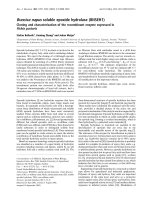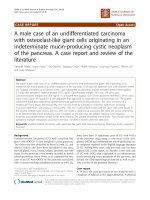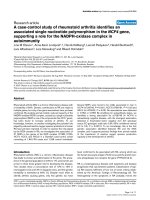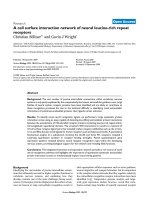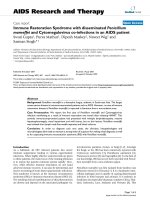Báo cáo y học: "A 60-year-old man with chronic renal failure and a costal mass: a case report and review of the literature" docx
Bạn đang xem bản rút gọn của tài liệu. Xem và tải ngay bản đầy đủ của tài liệu tại đây (874.29 KB, 5 trang )
Case report
Open Access
A 60-year-old man with chronic renal failure and a costal mass:
a case report and review of the literature
Germán Campuzano-Zuluaga*, William Velasco-Pérez and
Juan Ignacio Marín-Zuluaga
Address: Department of Internal Medicine, Hospital Pablo Tobón Uribe, Calle 78B No. 69-240, Medellín, Colombia
Email: GCZ* - ; WVP - ; JIMZ -
* Corresponding author
Received: 23 December 2008 Accepted: 24 December 2008 Published: 4 August 2009
Journal of Medical Case Reports 2009, 3:7285 doi: 10.4076/1752-1947-3-7285
This article is available from: />© 2009 Campuzano-Zuluaga et al.; licensee Cases Network Ltd.
This is an Open Access article distributed under the terms of the Creative Commons Attribution License (
/>which permits unrestricted use, distribution, and reproduction in any medium, provided the original work is properly cited.
Abstract
Introduction: Brown tumors are a rare focal manifestation of osteitis fibrosa cystica, which results
from hyperparathyroidism. Chronic kidney failure may lead to secondary or tertiary hyperpara-
thyroidism and thus to osteitis fibrosa cystica and brown tumors.
Case presentation: A 60-year-old man with a history of diabetes mellitus and chronic kidney
failure presented with a 15-day history of dyspnea, cough, malaise and fever. Initially, there was little
correlation between his history and his physical examination. Various pulmonary, cardiac and
infectious etiologies were ruled out. A chest X-ray showed a costal mass that was further verified by
tomography and gammagraphy. The mass was suspected of being neoplastic. After a failed biopsy, the
mass was removed surgically and on histopathology was compatible with a giant-cell tumor versus a
brown tumor caused by hyperparathyroidism. Laboratory tests showed elevated calcium, phosphate
and parathyroid hormone concentrations. The patient was diagnosed with a brown tumor secondary
to refractory hyperparathyroidism.
Conclusion: Tending towards a diagnosis because it is more frequent or it implies more risk for the
patient may delay the consideration of other diagnostic options that, although rare, fit well into the
clinical context. The patient presented here was suspected to have an osseous neoplasia that would
have had major implications for the patient. However, reassessment of the case led to the diagnosis of
a brown tumor. Brown tumors should be an important diagnostic consideration in patients with
chronic kidney failure who have secondary or tertiary hyperparathyroidism and an osseous mass.
Introduction
The first case in the literature reporting a brown tumor was
published in 1953 and described a fronto-ethmoidal brown
tumor [1]. However, previous reports of patients with
localized forms of osteitis fibrosa cystica (OFC) suggest
that the clinical entity was described earlier, at a time when
there were few treatment options for chronic kidney failure
(CKF) and consequently chronic hyperparathyroidism was
Page 1 of 5
(page number not for citation purposes)
more prevalent. Brown tumors are rare osseous lesions that
represent a focal manifestation of OFC resulting from
hyperparathyroid states. Patients suffering from CKF may
develop secondary or tertiary hyperparathyroidism due to
altered phosphorus and calcium metabolism. Persistent
hyperparathyroidism leads to altered osseous metabolism
with bone resorption and tissue changes collectively known
as OFC. Our case report describes a patient with poorly
controlled CKF who presented with a non-specific clinical
picture and no clear diagnosis. Incidentally a costal mass was
found and the diagnostic workup that followed led to an
unexpected diagnosis.
Case presentation
A 60-yea r-old ma n was transferred f rom the he modialysis
unit to the emergency room because of a 15-day h istory of
malaise, subjective fever, shortness of breath, dry cough,
abdominal pain a nd diarrhea. He also complained o f mild
anterior thoracic pain not a ssocia ted with o ther s ympt oms
and which was not irradiated. He had a 20-year history of
type 2 d ia betes m ellitus (DM) t hat r equired in s ulin, w ith
micro- and m acro-vascular complications such as dia betic
retinopathy and CKF. He was on hemodialysis and had a
history of multiple failed dialysis accesses. He also suffered
from arterial hypertension, upper and lower extremity
peripheral arteria l disease, carotid a rtery disease, a first d egree
atrioventricular h e art block and had sm oked one packet of
cigarettes per day for the last 20 years. He was being treated
with sevelamer, er y thropoietin, folic acid, lovastatin, gemfi-
brozil, NPH insulin, amlodipine and acetylsalicylic acid, but
was not receiving calcium or a vitamin D supplement.
A physical examination revealed the patient to be in a fair
condition, with no apparent distress, hydrated, alert and
well oriented. He had a heart rate of 92 beats per minute,
respiratory rate of 14 breaths per minute, blood oxygen
saturation of 97%, arterial blood pressure of 130/70 mmHg
andnofever.Hehadbilateralblindnessandmildepistaxis
throughthe left nostril. The thorax was tender to palpation in
some costochondral unions, but pain was poorly localized.
The vesicular murmur had reduced intensity and no
pathologic sounds were auscultated. Peripheral pulses were
weak in both the upper and the lower limbs. He had a
translumbar hemodialysis catheter. The remaining physical
examination was unremarkable.
The patient had stable vital signs and had no signs of
systemic inflammatory response. However, because of the
patient's previous history of DM, CKF and the presence of
leukocytosis, neutrophilia and elevated C-reactive protein
upon admission (Table 1), we initially ruled out a
gastrointestinal or lung infection, or any cardiac cause
for the patient's symptoms. The electrocardiogram showed
no signs of ischemia, and the chest X-ray showed
cardiomegaly, a small left pleural effusion, a circular
opacity in the right inferior thoracic region and no signs of
consolidation. These findings were initially interpreted as
a pulmonary infection, probably a lung abscess, an
abscedated nodule or pulmonary tuberculosis. A contrast
tomography scan of the chest was ordered for further
characterization. Though it showed no parenchymal
compromise, a 4 × 1.3 cm lesion was observed on the
right dorsal region of the eighth rib. The lesion showed
thinning of cortical bone in some areas, preserved cortex
and lacked periosteal reaction (Figure 1). The radiology
staff considered a bone metastasis as a first diagnostic
option, and a thoraco-abdomino-pelvic tomography scan
was done in search for more lesions and a probable
primary tumor. Additional hypodense lesions were
observed, including one on the left lamina of L4,
acetabulum, and head and neck of the right femur. There
was no lymph-node or internal organ compromise. A Tc
Table 1. Laboratory results upon admission and throughout hospital stay
Laboratory exams (reference range) Day 1 Day 2 Day 7 Day 9 Day 18 Day 20
Hemoglobin (13.5-17.5 g/dl) 8.7 6.7 8.2 7 7.8
Platelets (150-350×10
3
/mm
3
) 456 559
Leukocytes (4.5-11×10
3
/mm
3
) 14.5 10
Neutrophils (40-70%) 82 70
Lymphocytes (22-44%) 2 14
CRP (0.08-3.1 mg/liter) 12.20
Creatinine (<1.5 mg/dl) 6.5
BUN (10-20 mg/dl) 43
Sodium (136-145 mg/dl) 137 140 139
Potassium (3.5-5 mg/dl) 5.0 7.4 5.9
Calcium (9-10.5 mg/dl) 11.2 9.5 9.1 9.2
Phosphorus (3-4.5 mg/dl) 5.3
Alkaline phosphatase (30-120 U/liter) 139
Troponin
*
(0-0.4 ng/ml) 1.83 1.19
Fecal occult blood Negative
PSA (0-4 ng/ml) 0.748
CEA 0-3.4 (μg/liter) 3.6
* Chronic renal failure may elevate troponin levels independently from myocardial damage.
Page 2 of 5
(page number not for citation purposes)
Journal of Medical Case Reports 2009, 3:7285 />99 m Medronate osseou s gammagraphy reported a
hypermetabolic focus compatible with a neoplastic lesion,
concordant in size and location with the costal mass
reported in the previous imaging studies. It also revealed
generalized osseous compromise compatible with renal
osteodystrophy and did not confirm the other lesions
described on tomography. A tomography-guided biopsy
specimen (Figure 1) was obtained, but histopathological
analysis reported normal tissue components.
Not being able to reach a clear diagnosis, a careful
reassessmentofthepatient’s clinical record led to
considering the alternative diagnosis of renal osteodystro-
phy. This was supported by a history of poorly controlled
CKF, elevated calcium (11.2 mg/dl) and phosphorus
(5.3 mg/dl) concentrations, a phosphocalcic product of
59.36 mg
2
/dl
2
, and a bone gammagraphy that showed
changes compatible with OFC. However, the possibility of
neoplasia was still being considered so the mass was
removed surgically. Histopathological studies reported an
osseous tissue with spindles of fusiform cells in a storiform
disposition with abundant multinucleated giant cells,
some macrophages and some mononuclear cells. Scarce
mitotic activity was observed, and there were no signs of
malignancy (Figure 2). The pathologist concluded that the
findings were compatible with a giant-cell tumor or a
brown tumor, both histologically very similar [2]. Para-
thyroid hormone (PTH) concentration was 1377 pg/ml.
These findings were compatible with refractory hyperpar-
ath yroi dism, and a diagnosis of a brown tumor of
hyperparathyroidism associated with CKF was reached.
The patient continued ambulatory medical treatment with
vitamin D, calcium and sevelamer. Two months after
discharge, the parathyroid level was 1900 pg/ml and a Tc
99 m Sestamibi scan revealed hyperfunctioning glands
despite aggressive pharmacological treatment. Serum
calcium and phosphorus levels were within normal limits,
9.4 mg/dl and 3.4 mg/dl, respectively. At the time of
writing, the patient was awaiting parathyroidectomy as
definite treatment for tertiary hyperparathyroidism asso-
ciated with severe renal osteodystrophy.
Discussion
Brown tumors are unusual bone lesions that represent a
localized manifestation of OFC induced by hyperpara-
thyroidism, independent of its cause. Increased PTH levels
and locally produced tumour necrosis factor a and
interleukin 1 (IL-1) by marrow monocytes induce the
proliferation and differentiation of pluripotent bone-
marrow cells into osteoblasts. These cells produce granu-
locyte macrophage colony stimulating factor, IL-6, IL-11
and stem-cell factor that induce the migration and
differentiation of monocytes into osteoclasts, increasing
the number of the latter in the bone tissue. Enhanced
activity of oste oclasts and osteoblasts leads to bone
resorption and a reduction of bone mineral concentration
with an increased proliferation of fibrous tissue and
extracellular matrix [3]. Brown tumors develop in 3% to
4% of patients with primary hyperparathyroidism and in
1.5% to 1.7% of pati ents with secondary causes of
hyperparathyroidism [4]. However, around half of
patients with CKF may develop OFC due to secondary
hyperparathyroidism making brown tumors more fre-
quent in these patients. Brown tumors have been reported
in patients with primary hyperparathyroidism due to
Figure 1. Tomographic image during guided biopsyprocedure.
Note the heterogeneous 4 × 1.3 cm mass (arrow), with
preserved cortical bone and no periosteal reaction or other
inflammatory signs. No cysts were identified.
Figure 2. Microscopic pathology of surgical specimen.
Presence of various multinucleated giant cells (arrows) and
spindle arranged cells. Hemosiderin deposits were not
observed in the sample. Hematoxylin-eosin stain at
40 × magnification.
Page 3 of 5
(page number not for citation purposes)
Journal of Medical Case Reports 2009, 3:7285 />adenomas [5] and carcinomas [6] of the parathyroid
gland; vitamin D deficiency due to lack of sunlight ex-
posure [7] or due to intestinal malabsorption syndromes
[8]; and secondary [9] or tertiary hyperthyroidism [10] in
patients suffering CKF. Hyperphosphatemia with hypo-
calcemia caused by tubular damage and impaired
vitamin D metabolism explains hyperparathyroidism in
these patients.
Brown tumors are either mono- or polyostotic benign
masses, painless and usually found incidentally. However,
they may cause tissue damage to adjacent structures and
compressive manifestations such as pain, neuropathies
[11] and myelopathy [12]. The majority of cases report the
maxilla and mandible as the main sites of occurrence [9].
Other common sites are the clavicles, scapula, pelvis and
ribs; however, these lesions may appear in any osseous
structure [7], including chondral tissue [13]. They are
associated with an increased risk of fractures if localized in
weight-bearing areas [14].
Brown tumors arise from foci of OFC and represent a
reparative bone process rather than true neoplastic
lesions, as there is no hyperplasia or clonal cell pro-
liferation. Typical histopathology describes spindle cells
or fibroblasts in areas of osseous lysis, multinucleated
giant cells (probably osteoclasts), increased vasculariza-
tion and accumulation of hemosiderin-laden macro-
phages, with micro-hemorrhages which confer a
brownish appearance to the affected tissue. Cysts and
areas of necrosis may be found [2,5]. Brown tumors are
histologically similar to giant-cell tumors, giant-cell
regenerative granulomas, cherubism and aneurismatic
osseous cysts [2,4].
On X-ray imaging, brown tumors appear as lytic lesions
with thinned cortical bone that may be fractured.
Concurrent changes that suggest OFC such as osteope-
nia, a “salt-and-pepper” bone appearance, subperiosteal
bone resorption and disap pea rance of the lamina dura
around the roots of the teeth, may help differentiate it
from other entities [4]. Tomographic imaging shows an
osseous mass, with no cortical disruption, no periosteal
reaction or inflammatory signs, a heterogeneous center
and areas that suggest cysts [14]. Magnetic resonance
imaging (MRI) shows variable intensities on T2-
weighted images and intense enhancement on T1-
weighted contrast MRI. MRI may be better for determin-
ing the presence of cysts or fluid f illed levels; a finding
that is very suggestive of a brown tumor [14]. Osseous
gammagraphy is not indicated for the diagnosis of
brown tumors; however, isolated hypermetabolic lesions
or simultaneous hypercaptation of bone lesions and
parathyroid adenomas, when done with Tc 99 m Sesta-
mibi, have been descr ibed [15].
Although differential diagnoses for an isolated bone lesion
are extensive, when confronted with a patient with CKF, an
osseous mass and laboratory data that show increased
levels of calcium, phosphate, phosphocalcic product as
well as alkaline phosphatase, it is imperative to determine
PTH levels to rule out hyperparathyroidism. Histopatho-
logical analysis of the osseous lesion is needed to confirm
the diagnosis of a brown tumor. In the case presented here,
parathyroid levels were not assessed earlier because another
diagnosis, osseous neoplasia, was suspected which posed
major prognostic value and risk for the p atient. A
parathyroid hormone measurement six months earlier
reported 570 pg/ml; thus, it is probable that the patholo-
gical process evolved during this brief time.
Treatment of brown tumors relies on a definitive control
of the underlying hyperparathyroid state. In a patient with
CKF, this is achieved through the administration of
phosphorus chelators, and calcium and vitamin D sup-
plementation. In patients presenting with tertiary hyper-
parathyroidism, parathyroidectomy may be required.
Osseous lesions usually cease to grow, then shrink and
eventually ossify without further consequences for the
patient. Surgery is required under certain circumstances,
such as: 1) compressive neurologic symptoms over
peripheral nerves, cauda equina or spinal medulla; 2) a
significant anatomical deformity; 3) risk of a pathologic
fracture; 4) when the symptoms or pain do not resolve
despite adequate medical treatment and control of the
hyperparathyroid state; and 5) when the biopsy does not
yield a clear diagnosis, as with the present case [9,11,12].
Conclusion
The case presented here illustrates how brown tumors,
though rare, should be considered in patients with CKF
and an osseous mass. The initial clinical presentation of
this patient, a history of DM with a non-compensated CKF
and the laboratory studies suggested an infectious process.
Retrospectively, these initial complaints and findings
could be explained by the patient’s renal condition with
volume overload, severe anemia, hydro-electrolyte distur-
bances, as well as altered calcium and phosphate metabo-
lism. Early diagnosis and proper management of CKF
enable an optimal control of bone-mineral metabolism,
thus decreasing the incidence of OFC and making brown
tumors rare lesions. Nevertheless, when confronted with a
patient with CKF and an osseous mass, a brown tumor
caused by hyperparathyroidism should always be consid-
ered in the differential diagnosis.
Abbreviations
CKF, chronic kidney failure; DM, diabetes mellitus; IL-1,
interleukin 1; IL-6, interleukin 6; IL-11, interleukin 11;
MRI, magnetic resonance imaging; OFC, osteitis fibrosa
cystica; PTH, parathyroid hormone.
Page 4 of 5
(page number not for citation purposes)
Journal of Medical Case Reports 2009, 3:7285 />Consent
Written informed consent was obtained from the patient
for publication of this case report and accompanying
images. A copy of the written consent is available for
review by the Editor-in-Chief of this journal.
Competing interests
The authors declare that they have no competing interests
regarding this case report.
Authors’ contributions
GCZ summarized and interpreted the patient's medical
record and was part of the medical staff, did the literature
review and wrote the manuscript. WV and JIMZ helped to
interpret the patient’s medical record, were part of the
medical staff and helped to write and review the manu-
script. JIMZ was the principal attending physician and
responsible for most medical decisions and interpretations
expressed in the article. All authors read and approved the
final manuscript.
Acknowledgements
We thank the following persons: the patient and his family
for the information provided and their approval for the
publication of this case; the medical staff at the Hospital
Pablo Tobón Uribe, especially the Internal Medicine,
Radiology, Surgery and Pathology Departments, and the
Nephrology and Dialysis Unit; Dr. Victoria Eugenia
Murillo for histopathological analysis, case discussion
and photomicrography; Dr. John M. Lopera, Dr. Jorge
H. Donado and Ana Isabel Toro for manuscript revision
and editing.
References
1. Guarnaccia E: [Brown fronto-ethmoidal tumor; contribution
to the knowledge of cranial localizations of the fibrocystic
osteopathies]. Otorinolaringol Ital 1953, 21:175-189.
2. Mafee MF, Yang G, Tseng A, Keiler L, Andrus K: Fibro-osseous and
giant cell lesions, including brown tumor of the mandible,
maxilla, and other craniofacial bones. Neuroimaging Clin N Am
2003, 13:525-540.
3. Hruska K: New concepts in renal osteodystrophy. Nephrol Dial
Transplant 1998, 13:2755-2760.
4. Takeshita T, Tanaka H, Harasawa A, Kaminaga T, Imamura T, Furui S:
Brown tumor of the sphenoid sinus in a patient with
secondary hyperparathyroidism: CT and MR imaging find-
ings. Radiat Med 2004, 22:265-268.
5. Fernandez-Sanroman J, Anton-Badiola IM, Costas-Lopez A: Brown
tumor of the mandible as first manifestation of primary
hyperparathyroidism: diagnosis and treatment. Med Oral Patol
Oral Cir Bucal 2005, 10:169-172.
6. Pahlavan PS, Severin MC: Parathyroid carcinoma: A rare case
with mandibular brown tumor. Wien Klin Wochenschr 2006,
118:175-179.
7. Erturk E, Kesk in M, Ersoy C, Kaleli T, Imamoglu S, Filiz G:
Metacarpal brown tumor in secondary hyperparathyroidism
due to vitamin-D deficiency A case report. J Bone Joint Surg Am
2005, 87:1363-1366.
8. Ehrlich GW, Genant HK, Kolb FO: Secondary hyperparathyroid-
ism and brown tumors in a patient with gluten enteropathy.
AJR Am J Roentgenol 1983, 141:381-383.
9. Jeren-Strujic B, Rozman B, Lambasa S, Jeren T, Markovic M, Raos V:
Secondary hyperparathyroidism and brown tumor in dia-
lyzed patients. Ren Fail 2001, 23:279-286.
10. Pinto LP, Cherubinim K, Salum FG, Yurgel LS, de Figueiredo MA:
Highly aggressive brown tumor in the jaw associated with
tertiary hyperparathyroidism. Pediatr Dent 2006, 28:543-546.
11. TarrassF,AyadA,BenjellounM,AnabiA,RamdaniB,
Benghanem MG, Zaid D: Cauda equina compression revealing
brown tumor of the spine in a long-term hemodialysis
patient. Joint Bone Spine 2006, 73:748-750.
12. Kaya RA, Cavusoglu H, Tanik C, Kahyaoglu O, Dilbaz S, Tuncer C,
Aydin Y: Spinal cord compression caused by a brown tumor at
the cervicothoracic junction. Spine J 2007, 7:728-732.
13. Perrin J, Zaunbauer W, Haertel M: Brown tumor of the thyroid
cartilage: CT findings. Skeletal Radiol 2003, 32:530-532.
14. Takeshita T, Takeshita K, Abe S, Takami H, Imamura T, Furui S:
Brown tumor with fluid-fluid levels in a patient with primary
hyperparathyroidism: radiological findings. Radiat Med
2006,
24:631-634.
15. Yapar AF, Aydin M, Reyhan M, Bal N, Yapar Z, Yologlu NA:
Simultaneous visualization of a mandibular brown tumor
with a large parathyroid adenoma on Tc-99 m MIBI imaging.
Clin Nucl Med 2005, 30:433-435.
Page 5 of 5
(page number not for citation purposes)
Journal of Medical Case Reports 2009, 3:7285 />Do you have a case to share?
Submit your case report today
• Rapid peer review
• Fast publication
• PubMed indexing
• Inclusion in Cases Database
Any patient, any case, can teach us
something
www.casesnetwork.com

